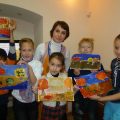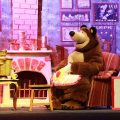This is a great time to tell.young naturalists about nature. You can do this with the help of books. For example, artbooks known all over the world about the nature of Dianna Aston, which were published by the publishing house “Myth”.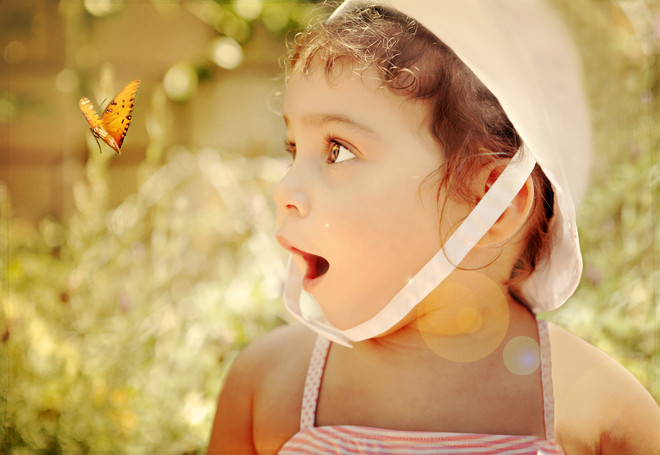 A photo: Getty ImagesThe series includes 6 books with beautiful detailed illustrations and informative texts. Each of them reveals one topic: butterflies, beetles, nests, seeds, eggs, and stones. The books help to present information easily and entertainingly, they are bright and beautiful, so children really like it. And on them you can arrange developmental activities. We offer 6 ideas right now.
A photo: Getty ImagesThe series includes 6 books with beautiful detailed illustrations and informative texts. Each of them reveals one topic: butterflies, beetles, nests, seeds, eggs, and stones. The books help to present information easily and entertainingly, they are bright and beautiful, so children really like it. And on them you can arrange developmental activities. We offer 6 ideas right now.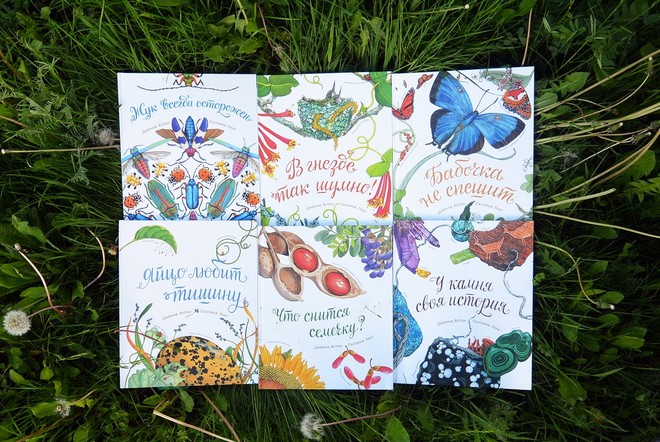 Photo: “Myth” publishing house
Photo: “Myth” publishing house
Layout of the nest: an idea from the book "In the nest is so noisy"
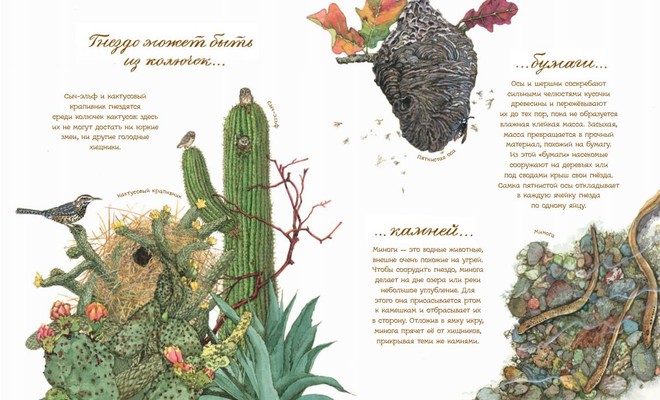 Photo:Publishing house "MYTH"Make models of interesting nests, for example, a nest in a pot with a cactus, among its thorns, like a cactus wren (a small bird), from stones, like lampreys - small aquatic animals similar to eels (they build nests from stones in a small depression at the bottom of a lake or river), from paper, like wasps and hornets (make a semblance of a beehive), from a large pile of leaves and branches, like a jungle fowl (the pile should be large, because this bird builds nests up to 5 meters high, this is how it saves eggs from predators).
Photo:Publishing house "MYTH"Make models of interesting nests, for example, a nest in a pot with a cactus, among its thorns, like a cactus wren (a small bird), from stones, like lampreys - small aquatic animals similar to eels (they build nests from stones in a small depression at the bottom of a lake or river), from paper, like wasps and hornets (make a semblance of a beehive), from a large pile of leaves and branches, like a jungle fowl (the pile should be large, because this bird builds nests up to 5 meters high, this is how it saves eggs from predators).
The structure of the beetle: an idea from the book "The Beetle is always careful"
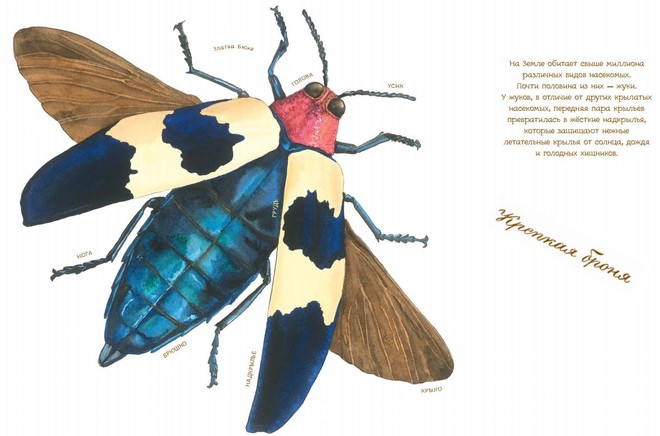 A photo: Publishing House “Myth” Find pests and beneficial beetles in the country. Catch in a jar, for example, the Colorado potato beetle, consider the structure of its body, show all the parts to the child. Tell your child how bugs are different from ordinary insects. They have a front pair of wings turned into hard elytra, which protect the delicate flying wings from the sun, rain and hungry predators.
A photo: Publishing House “Myth” Find pests and beneficial beetles in the country. Catch in a jar, for example, the Colorado potato beetle, consider the structure of its body, show all the parts to the child. Tell your child how bugs are different from ordinary insects. They have a front pair of wings turned into hard elytra, which protect the delicate flying wings from the sun, rain and hungry predators.
How a butterfly appears: an idea from the book “Butterfly is in no hurry”
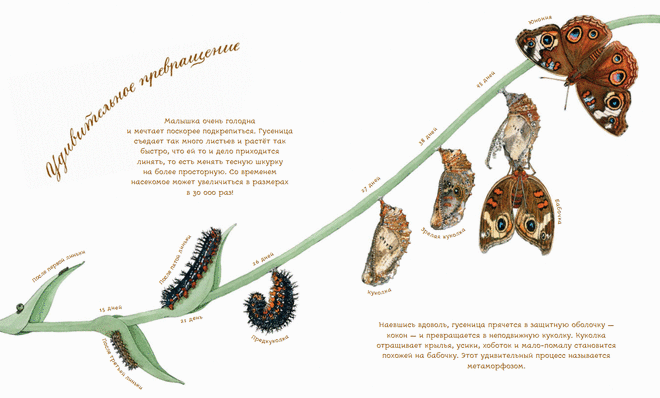 Photo:Publishing house "MYTH"In the summer, try to find a butterfly chrysalis. Describe to the child all the stages of insect development, tell him that the chrysalis is an intermediate stage between the egg and the butterfly. Explain how the butterfly's body develops inside the cocoon (its wings, antennae, proboscis grow, and on the 45th day after the egg hatches, the butterfly is born).
Photo:Publishing house "MYTH"In the summer, try to find a butterfly chrysalis. Describe to the child all the stages of insect development, tell him that the chrysalis is an intermediate stage between the egg and the butterfly. Explain how the butterfly's body develops inside the cocoon (its wings, antennae, proboscis grow, and on the 45th day after the egg hatches, the butterfly is born).
What does a seed consist of: an idea from the book “What is a Dreaming of a Seed?”
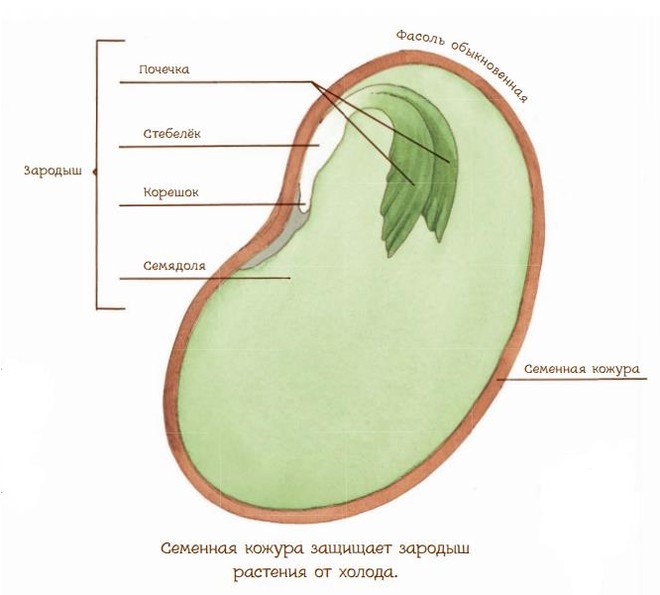 A photo: “Myth” publishing house. Take a larger seed and explain to the child what it is made of and how the germ is formed from it, and then the plant. Show the children that under the shell (seed skin) many interesting things are hidden.
A photo: “Myth” publishing house. Take a larger seed and explain to the child what it is made of and how the germ is formed from it, and then the plant. Show the children that under the shell (seed skin) many interesting things are hidden.
How does a chicken: an idea from the book "Egg loves silence"
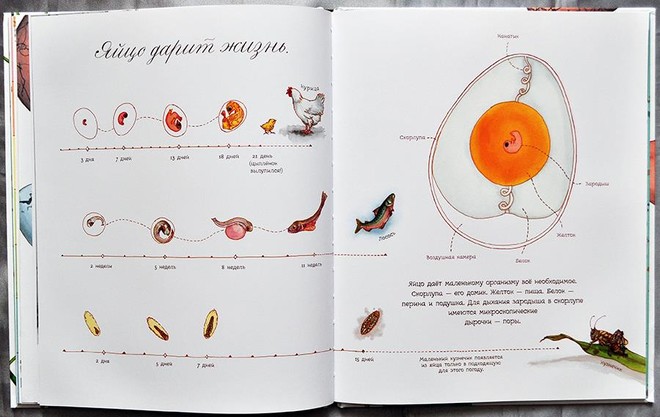 Photo:Publishing house "MYTH"All children want to know how a chick emerges from an egg. Take a chicken egg and use this diagram to tell your child what it consists of. Explain that the shell is a house for the embryo, the yolk is its food, the white is a feather bed and pillow, and for the embryo to breathe, there are pores in the shell. Show children how different embryos mature: a chicken, a salmon, and a grasshopper.
Photo:Publishing house "MYTH"All children want to know how a chick emerges from an egg. Take a chicken egg and use this diagram to tell your child what it consists of. Explain that the shell is a house for the embryo, the yolk is its food, the white is a feather bed and pillow, and for the embryo to breathe, there are pores in the shell. Show children how different embryos mature: a chicken, a salmon, and a grasshopper.
What the stones consist of: an idea from the book “The Stone has its own story”
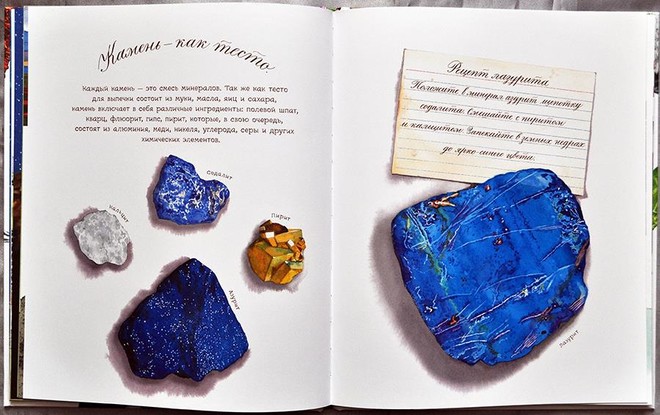 Photo:Publishing house "MYTH"Tell your child about beautiful and unusual stones that are hard to find in the city or on the beach, such as: calcite, sodalite, azurite, pyrite, lapis lazuli. Show each of these stones and tell them that they all consist of minerals. Just as baking dough consists of flour, butter, eggs and sugar, a stone includes various ingredients: feldspar, quartz, fluorite, gypsum, pyrite, which consist of chemical elements. Studying nature is a bright and exciting process for children of any age. Give your child the joy of discovery with the help of Dianna Aston's art books.
Photo:Publishing house "MYTH"Tell your child about beautiful and unusual stones that are hard to find in the city or on the beach, such as: calcite, sodalite, azurite, pyrite, lapis lazuli. Show each of these stones and tell them that they all consist of minerals. Just as baking dough consists of flour, butter, eggs and sugar, a stone includes various ingredients: feldspar, quartz, fluorite, gypsum, pyrite, which consist of chemical elements. Studying nature is a bright and exciting process for children of any age. Give your child the joy of discovery with the help of Dianna Aston's art books.






